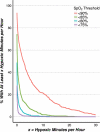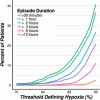Postoperative Hypoxemia Is Common and Persistent: A Prospective Blinded Observational Study
- PMID: 26287299
- PMCID: PMC4825673
- DOI: 10.1213/ANE.0000000000000836
Postoperative Hypoxemia Is Common and Persistent: A Prospective Blinded Observational Study
Abstract
Background: The incidence, severity, and duration of postoperative oxygen desaturation in the general surgical population are poorly characterized. We therefore used continuous pulse oximetry to quantify arterial oxygen saturation (SpO2) in a cross-section of patients having noncardiac surgery.
Methods: Oxygen saturation, blinded to clinicians, was recorded at 1-minute intervals in patients >45 years old for up to 48 hours after noncardiac surgery in 1250 patients from Cleveland Clinic Main Campus and 250 patients from the Juravinski Hospital. We determined (1) the cumulative minutes of raw minute-by-minute values below various hypoxemic thresholds; and (2) the contiguous duration of kernel-smoothed (sliding window) values below various hypoxemic thresholds. Finally, we compared our blinded continuous values with saturations recorded during routine nursing care.
Results: Eight hundred thirty-three patients had sufficient data for analyses. Twenty-one percent had ≥10 min/h with raw SpO2 values <90% averaged over the entire recording duration; 8% averaged ≥20 min/h <90%; and 8% averaged ≥5 min/h <85%. Prolonged hypoxemic episodes were common, with 37% of patients having at least 1 (smoothed) SpO2 <90% for an hour or more; 11% experienced at least 1 episode lasting ≥6 hours; and 3% had saturations <80% for at least 30 minutes. Clinical hypoxemia, according to nursing records, measured only in Cleveland Clinic patients (n = 594), occurred in 5% of the monitored patients. The nurses missed 90% of smoothed hypoxemic episodes in which saturation was <90% for at least one hour.
Conclusions: Hypoxemia was common and prolonged in hospitalized patients recovering from noncardiac surgery. The SpO2 values recorded in medical records seriously underestimated the severity of postoperative hypoxemia.
Figures





Comment in
-
Continuous remote monitoring to detect critical early warning scores after abdominal surgery: A prospective cohort study.Eur J Anaesthesiol. 2021 Jun 1;38(6):673-675. doi: 10.1097/EJA.0000000000001472. Eur J Anaesthesiol. 2021. PMID: 33967262 No abstract available.
References
-
- Hodari A, Tsiouris A, Eichenhorn M, Horst M, Rubinfeld I. Exploring National Surgical Quality Improvement Program respiratory comorbidities: developing a predictive understanding of postoperative respiratory occurrences, Clavien 4 complications, and death. J Surg Res. 2013;183:663–7. - PubMed
-
- Leuvan CH, Mitchell I. Missed opportunities? An observational study of vital sign measurements. Crit Care Resusc. 2008;10:111–15. - PubMed
-
- MacIntyre NR. Supporting oxygenation in acute respiratory failure. Respir Care. 2013;58:142–50. - PubMed
-
- Abdelmalak BB, Cata JP, Bonilla A, You J, Kopyeva T, Vogel JD, Campbell S, Sessler DI. Intraoperative tissue oxygenation and postoperative outcomes after major non-cardiac surgery: an observational study. Br J Anaesth. 2013;110:241–9. - PubMed
Publication types
MeSH terms
Grants and funding
LinkOut - more resources
Full Text Sources
Medical

